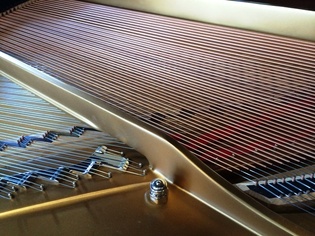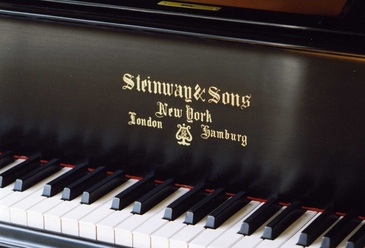 Image © by Brian E. Faulkner
Image © by Brian E. Faulkner Go to a piano store and lift the lid on a grand of any size. Unless you are a true piano aficionado, for whom even the slightest difference between instruments can be an endless source of amazement and delight, you will find a golden plate (or harp) crisscrossed by an array of bronze and silver colored strings contained within a hefty case that makes that instrument look a lot like the one next to it. However, pianos are anything but alike in tone and touch, the primary criteria pianists use to evaluate the world’s best instruments – mostly hand-crafted in Europe but also including two premier quality holdovers from piano’s so-called golden age in the U.S., Steinway & Sons and Mason & Hamlin.
Even so, top-tier piano makers typically describe their products in technical rather than tactile terms. Surprisingly, hardly any differentiate their instruments by their tonal palette.
“To most piano buyers and owners,” writes Larry Fine in his publication, The Acoustical and Digital Piano Buyer, “a piano's tone is probably its most important aspect, but also the most difficult to quantify or describe.”
“There’s only so much that words can say about piano sound,” agrees Eric Johnson, a Registered Piano Technician and piano industry veteran with an MBA from Cornell who has prepped and tuned pianos for “some really great pianist in some really great concert halls,” including Carnegie, Avery Fischer, Alice Tully, Detroit, Chicago, LA, and San Francisco. (http://www.ericjohnsonpianos.com/ )
“Differentiating one piano from another is a tough thing,” he says, “which is why copywriters so often fall back on design and build processes and brand history.”
So how do piano makers communicate their performance difference? Mostly they don’t, knowing that playing and listening to pianos is largely a subjective experience. They’re confident enough in their products to leave praise about tone and touch to the players of their instruments, people who are not shy with their opinions and likely will have gone through an exhaustive audition process before selecting their piano. The makers then reflect the experience of these brand advocates back to the marketplace, where future buyers will read or hear the accolades.
But words mean different things to different people.
“You can say one piano is bright and another is warm, one is powerful, another is lyrical,” notes Johnson. “But that distinction is made in the mind of the player. I see that every time somebody tries to describe some uniquely personal combination of tone and touch they want me to coax from their instrument.”
 Artcase Bösendorfer designed by glass artist Jon Kuhn
Artcase Bösendorfer designed by glass artist Jon Kuhn The artists who make the music aren’t likely to mention how their piano’s hammers are made or point out whether the bridge cap grain runs vertically or horizontally. But they can close their eyes and know what their piano sounds like. They can hear it in their dreams … sometimes even before they find that “perfect piano.”
“It is uniqueness that I seek,” says acclaimed classical artist Valentina Lisitsa in praise of Vienna's famed Bösendorfer. “Bösendorfer gives me a unique voice, unique palette of musical colors, unique tools to achieve my vision.”
Larry Fine describes Bösendorfer in more prosaic terms: “Perhaps the world's most expensive piano inch for inch, Bösendorfer grands make an eloquent case for their prices. They are distinctive in both appearance and sound, and are considered to be among the finest pianos in the world.”
 1890s Steinway - Image © by Brian E. Faulkner
1890s Steinway - Image © by Brian E. Faulkner And here’s Fine’s take: “Steinway pianos at their best have the quintessential American piano sound: a powerful bass, a resonant midrange, and a singing treble with plenty of tonal color. Although other brands have some of these characteristics, it is perhaps the particular combination of harmonics that comprise the Steinway's tonal coloration that, more than anything else, distinguishes it from other brands and gives it its richness, depth, and power.”
DO Your Customers SING YOUR SONG?
> Do your customers or clients sing your praises?
> Does what they have to say enhance or conflict with what you communicate in your tagline, marketing
materials, advertising, positioning / capabilities videos and sales conversations?
> Do their words prompt others to want what you have, to experience your product’s performance for
themselves?
If you don’t know the answers to these questions, take a note from the world of high performance pianos -- and start listening.
TakeAway: Customers can be your best brand advocates. So can the people who write articles that your best prospects will read.
Tags: Steinway & Sons, Yamaha, Mason & Hamlin, Bosendorfer, Eric Johnson, Registered Piano Technician, Larry Fine, The Acoustical and Digital Piano Buyer, Valentina Lisitsa, Emanuel Ax
Content © by Brian E. Faulkner
About Brian Faulkner:
> blogs to establish you as the knowledge source / authority in your business category
> case stories that communicate your sales successes and invite prospect inquiry
> testimonials that showcase customer / client satisfaction in 1-2 short sentences
> positioning statements to guide business development & marketing
> landing page copy to set your business or brand apart in a compelling way
> tagline development to attract the interest of your most qualified prospects
Brian also is a three-time Emmy award winning Public Television writer and narrator of UNC-TV’s popular "Our State" magazine series, on the air since 2003. His distinctive sound has been heard on many hundreds of radio spots and client videos since the 1970s. People say he has a "Mercedes voice" and sounds a bit like Charles Kuralt, which Brian considers a welcome ... but happy ... illusion.

 RSS Feed
RSS Feed